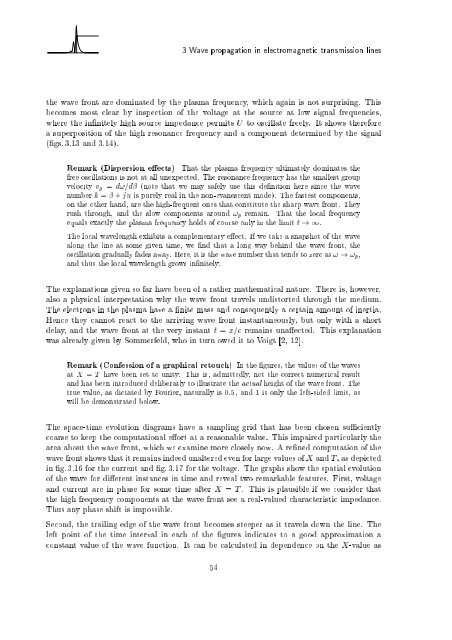Wave Propagation in Linear Media | re-examined
Wave Propagation in Linear Media | re-examined
Wave Propagation in Linear Media | re-examined
You also want an ePaper? Increase the reach of your titles
YUMPU automatically turns print PDFs into web optimized ePapers that Google loves.
3<strong>Wave</strong> propagation <strong>in</strong> electromagnetic transmission l<strong>in</strong>es<br />
the wave front a<strong>re</strong> dom<strong>in</strong>ated by the plasma f<strong>re</strong>quency, which aga<strong>in</strong> is not surpris<strong>in</strong>g. This<br />
becomes most clear by <strong>in</strong>spection of the voltage at the source at low signal f<strong>re</strong>quencies,<br />
whe<strong>re</strong> the <strong>in</strong> nitely high source impedance permits U to oscillate f<strong>re</strong>ely. It shows the<strong>re</strong>fo<strong>re</strong><br />
a superposition of the high <strong>re</strong>sonance f<strong>re</strong>quency and a component determ<strong>in</strong>ed by the signal<br />
( gs. 3.13 and 3.14).<br />
Remark (Dispersion e ects) That the plasma f<strong>re</strong>quency ultimately dom<strong>in</strong>ates the<br />
f<strong>re</strong>e oscillations is not at all unexpected. The <strong>re</strong>sonance f<strong>re</strong>quency has the smallest group<br />
velocity vg = d!=d (note that we may safely use this de nition he<strong>re</strong> s<strong>in</strong>ce the wave<br />
number k = + j is pu<strong>re</strong>ly <strong>re</strong>al <strong>in</strong> the non-evanescent mode). The fastest components,<br />
on the other hand, a<strong>re</strong> the high-f<strong>re</strong>quent ones that constitute the sharp wave front. They<br />
rush through, and the slow components around !p <strong>re</strong>ma<strong>in</strong>. That the local f<strong>re</strong>quency<br />
equals exactly the plasma f<strong>re</strong>quency holds of course only <strong>in</strong> the limit t !1.<br />
The local wavelength exhibits a complementary e ect. If we take a snapshot of the wave<br />
along the l<strong>in</strong>e at some given time, we nd that a long way beh<strong>in</strong>d the wave front, the<br />
oscillation gradually fades away. He<strong>re</strong>, it is the wavenumber that tends to zero as ! ! !p,<br />
and thus the local wavelength grows <strong>in</strong> nitely.<br />
The explanations given so far have been of a rather mathematical natu<strong>re</strong>. The<strong>re</strong> is, however,<br />
also a physical <strong>in</strong>terp<strong>re</strong>tation why the wave front travels undistorted through the medium.<br />
The electrons <strong>in</strong> the plasma have a nite mass and consequently a certa<strong>in</strong> amount of <strong>in</strong>ertia.<br />
Hence they cannot <strong>re</strong>act to the arriv<strong>in</strong>g wave front <strong>in</strong>stantaneously, but only with a short<br />
delay, and the wave front at the very <strong>in</strong>stant t = x=c <strong>re</strong>ma<strong>in</strong>s una ected. This explanation<br />
was al<strong>re</strong>ady given by Sommerfeld, who <strong>in</strong> turn owed it to Voigt [2, 12].<br />
Remark (Confession of a graphical <strong>re</strong>touch) In the gu<strong>re</strong>s, the values of the waves<br />
at X = T have been set to unity. This is, admittedly, not the cor<strong>re</strong>ct numerical <strong>re</strong>sult<br />
and has been <strong>in</strong>troduced deliberatly to illustrate the actual height of the wave front. The<br />
true value, as dictated by Fourier, naturally is 0:5 , and 1 is only the left-sided limit, as<br />
will be demonstrated below.<br />
The space-time evolution diagrams have a sampl<strong>in</strong>g grid that has been chosen su ciently<br />
coarse to keep the computational e ort at a <strong>re</strong>asonable value. This impai<strong>re</strong>d particularly the<br />
a<strong>re</strong>a about the wave front, which we exam<strong>in</strong>e mo<strong>re</strong> closely now. A <strong>re</strong> ned computation of the<br />
wave front shows that it <strong>re</strong>ma<strong>in</strong>s <strong>in</strong>deed unalte<strong>re</strong>d even for large values of X and T , as depicted<br />
<strong>in</strong> g. 3.16 for the cur<strong>re</strong>nt and g. 3.17 for the voltage. The graphs show the spatial evolution<br />
of the wave for di e<strong>re</strong>nt <strong>in</strong>stances <strong>in</strong> time and <strong>re</strong>veal two <strong>re</strong>markable featu<strong>re</strong>s. First, voltage<br />
and cur<strong>re</strong>nt a<strong>re</strong> <strong>in</strong> phase for some time after X = T . This is plausible if we consider that<br />
the high f<strong>re</strong>quency components at the wave front see a <strong>re</strong>al-valued characteristic impedance.<br />
Thus any phase shift is impossible.<br />
Second, the trail<strong>in</strong>g edge of the wave front becomes steeper as it travels down the l<strong>in</strong>e. The<br />
left po<strong>in</strong>t of the time <strong>in</strong>terval <strong>in</strong> each of the gu<strong>re</strong>s <strong>in</strong>dicates to a good approximation a<br />
constant value of the wave function. It can be calculated <strong>in</strong> dependence on the X-value as<br />
54












